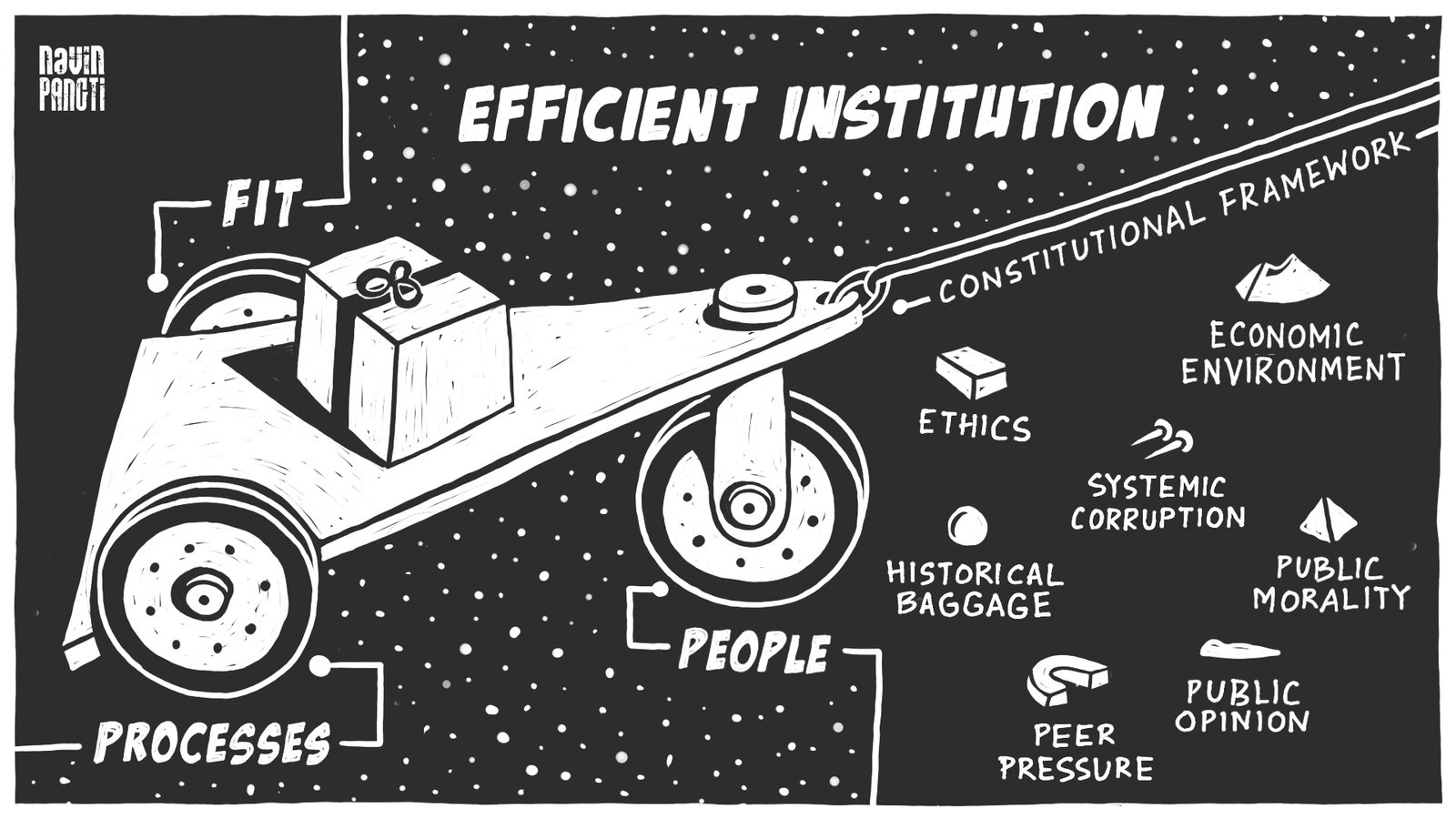FIT People and Processes Framework for institutional efficiency
When it comes to functioning of government institutions, we often end up making generalized statements about how things will never improve. And improve they will not, until we start making logical and objective assessments of the problems at hand.
The discussions around government institutions like medical services, schooling, police, etc., and even about democracy in general, often end with remarks like ‘they can never improve’ or that ‘we have hit the ceiling’. Such notions have almost become a public opinion of sorts. Blaming the system rather than understanding and addressing the real problems at hand suggest that the mess has been taken for granted. Reactive, rather than proactive, mode of functioning, knee jerk reactions and token gestures of civil society and government also seem to hint towards the same.
While there seems to be an overdose of business models in private sector, the public and government sector seems to be devoid of analytical approach towards understanding and solving problems. This model is an attempt to address that gap. The genesis of this model lies in my inability to discuss the ‘root’ causes of many of problems we face. In the absence of a logical framework such discussions become inconclusive as well as unending.
The model I am proposing is based on the People Process and technology (PPT) Framework used in the IT industry, especially in the IT enabled services industry.
FIT People and Processes Framework
FIT People and Processes Framework for institutional efficiency establishes the relationships between three core components of an institution – People, Processes, and FIT (Funds, Infrastructure & Technology). In order to achieve institutional efficiency it is imperative that the three components are in balance and harmoniously complement each other.
The model helps break down the institution, or its sub-parts, into discrete units so that we can independently assess each of the ‘parts’, which constitute the ‘whole’, and explore their interrelationships. This approach helps us identify various bottlenecks & roadblocks, and objectively understand the causes & relationships to come up with viable interventions.

‘FIT’ stands for Funds, Infrastructure and Technology. The term ‘Funds’ exclusively represents the monetary resources needed to cover the running costs of an institution. For example, schools, police stations or hospitals need money for salaries, consumables, day to day operational expenses, resources for regular upkeep and maintenance of infrastructure and technology, etc. Unlike private organizations which earn revenue, these institutions totally depend on inflow of funds.
‘Infrastructure’ stands for physical structures and assets like building, furniture, transportation, etc., while ‘Technology’ stands for tools and equipment needed to execute tasks for delivering the intended services. For ease of understanding let us not label the finances needed for development /creation /purchase of infrastructure and technology as funds. Such budgetary allocations are released for specific tasks whereas what we are calling ‘funds’ is the regular flow of money needed to keep an institution up and running.
‘Processes’ stands for regulatory procedures, governance and management frameworks, etc. As it is important to insure that realistic goals are set and then achieved within designated timeframes, the term processes also includes things like goals setting, monitoring KPIs (key performance indicators), defining best practices, audits, etc.
‘People’ represents the human resources who implement the ‘Processes’. This includes the professional skills, qualifications, awareness, competency, etc. of the workforce. It also represents reward mechanisms, work culture, induction & training programmes, etc.
While an overall synergy would lead to a ‘state of bliss’, synergy between various components bring in different values. Synergy between ‘People’ and ‘FIT’ leads to confidence, motivation and readiness whereas synergy between ‘People’ and ‘Processes’ results in effectiveness and efficiency. Synergy between ‘Processes’ and ‘FIT’ is essential for automation and scale.
It is important to note that all the three components are impacted by various government policies and have to work within the boundaries of legislative framework and the constitution. In the case of Technology, its relevance or effectiveness is also a function of where it stands with respect to where the world is in terms of the technology under evaluation.
While talking about people, it is important to note that apart from representing the institution, they also represent the society to which they belong. What they are and how they function largely represents the value system of the society they come from. The moral compass of the society and the individuals cannot be very different. So if there is a need for alteration then various processes have to be put in place to instill the desired value system. That’s where induction and training programmes play a major role.
Even though the framework talks about balance and harmony between the three components, they are not equal. The ‘People’ component is more equal than others because it is the people who eventually make things happen. A good set of people, in spite of all odds, will deliver value. Lack of clarity in processes or shortage in FIT will not blur their vision. The diagram below illustrates this relationship.

The tricycle is ‘powered’ by the constitutional framework. The front wheel represents ‘People’ and it is free to rotate about its axis. There are many hurdles on the way. The wheel can choose to stay on course or stray. We know that even when it strays, it will eventually move in the direction of the forced applied, unless that force ceases to exist. The force will cease to exist only when the constitution machinery fails. The free axis represents the will of the ‘People’ to succumb to or overcome the obstacles like systemic corruption, public morality, public opinion, ethics, economic environment, peer pressure, historical baggage, etc. The free axis of ‘People’ not only allows it to keep its course but also help the other two wheels overcome these obstacles.
Application of the framework
To understand the framework, take any generic statement people make about any institution and break it into these components. One will be able to identify various bottlenecks and roadblocks. Once identified, we can list them down in accordance to their impact and start working on them. There is a high chance that when we address a roadblock we would have cleared a few bottlenecks as well.
For example, lots of people believe that our judiciary is not functioning as it should. Is it just about people? Or processes? Or FIT?
Take Supreme Court for example. Some of the easily identifiable issues are –
- Infrastructure – A very small setup compared to the demographics that it represents
- Infrastructure – A centralized setup for such a large country is akin to denying access to the judicial system.
- Process – Subjective and arbitrary attributes of case allocation and judge selection processes
- Process – Technically operates through a single language. A non-English speaking person cannot represent himself or herself. SC judgments cannot be understood by the majority of the citizens. It is only now that the translations have been ordered.
So while one may blame the judges alone, the infrastructure and processes itself do not help the cause. Addressing infrastructure issues can actually solve many process issues as well.
One of the reasons that forced me to think about this model was the inconclusive discussions around the Revenue Police system of Uttarakhand. Many friends, activists and lawyers asked me why I was advocating for a regular police system which is so ‘corrupt’. This model helped me understand the nuances of the matter, which are as follows –
- A corrupt police system at various places is primarily a People issue followed by Processes.
- In our case we have a Revenue Police system which is equally corrupt. So People issues are almost the same.
- Unlike rest of the country, we have no Processes, no Infrastructure and no Technology. Hence no Funds.
- What we are asking for is all the three components. One failed component elsewhere cannot be a justification for the denial of the entire framework.
Another interesting example is government schools. People always blame teachers for non-functioning school. While people issue cannot be ruled out, there are problems at multiple other fronts like –
- People – Shortage of staff.
- Process – Unequal distribution of staff due to process oversight. Many schools in Uttarakhand have one teacher for say 60 students across many classes but the middle school near my home has 5 teachers for 25 children, i.e. 1 teacher per 5 children.
- Process – Inefficient auditing and almost nonexistent school management framework. Focus is more on creating school infrastructure rather than running them well.
- FIT – Government makes budgetary allocation for creation of infrastructure and technology but not for the upkeep of it hence the facilities remain underutilized, especially the library and computer labs.
- Infrastructure – Various provision of RTE still not deployed
Drilling down and going further
While this framework helps understand relationships at component level, one can drill down and make it more granular based on the nature of the institution to which the framework is being applied. As illustrated in the previous section, we can break the functioning of the whole institution into these components and established their relationships to understand the issues and address them. This will not only help user define various roadblocks and bottlenecks but also understand interdependencies and identify ‘real’ causes.
If any institution is willing to provide data and allow publishing of results in the public domain, I would be more than willing to apply this framework to understand issues regarding their institutional efficiency. This will also help me refine and fine-tune the framework and demonstrate its effectiveness.














